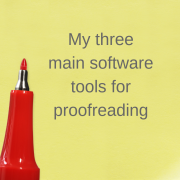My three main software tools for proofreading
Proofreading is hard. Your eyes gloss over mistakes because they see what they expect to see. (At least, mine often do this.) They read “portfolio manger” as “portfolio manager,” adding the missing “a.” This is why I use three software tools (other than spell-checking software) when accuracy and style matter most. The first tool is free; the others require annual subscriptions.
1. Microsoft Word’s Speak feature
Speak, the text-to-voice feature of Microsoft Word, is the most powerful tool I use for proofreading. It helps me catch problems that automated proofreading tools can’t catch. Of course, my process is challenging to use because it requires my active participation.
Here’s the process I suggest to you.
- Highlight one paragraph in your document, then click the Speak icon so your computer reads it out loud. (You may want to add Speak to your Quick Access Toolbar if it’s not there already.)
- Keep your eyes on your document as you listen carefully to your computer reading it out loud. This will help you catch typos like “portfolio manger.” It’ll also help you identify sentences that are clunky or other problems that you’ve missed.
- Correct mistakes as you go. Otherwise, you may forget to fix them.
- After you correct a sentence, have Word read it out loud again. Every time you edit something, you introduce the possibility of human error. A second reading has saved me from inflicting embarrassing mistakes on my clients.
Other Microsoft Office software—PowerPoint and Outlook—also offers Speak. Adobe Acrobat also offers a form of text-to-voice reading, as I discussed in “Why I love Adobe Acrobat Pro for proofreading.” Before I upgraded to a version of Word that includes Speak, I used to convert my Word documents to PDFs so Adobe could read them out loud to me.
2. PerfectIt
An earlier version of PerfectIt software was called the Consistency Tracker. I love that this software searches for consistency of punctuation and spelling. For example, do you spell a financial planner’s profession as “advisor” or “adviser”?
Of course, this consistency checking has its frustrations, too. It can’t appreciate that you hyphenate a term as a compound modifier but not as a standalone. For example, “financial planning” versus “financial-planning software.” Still the software makes it easy to view all examples of one spelling at a glance, so you can selectively change it with one click.
The software also checks for problems such as inconsistency in your bullets, whether you forgot to close quotes or brackets, and whether you have unnecessarily introduced an abbreviation because you only use the term once.
The software also:
- Tells you if you’ve left comments or tracked changes in your document
- Converts two or more spaces to one, which is important when I work on manuscripts with two spaces after periods
- Allows you to select different forms of English (American, Australian, British, or Canadian) or style guides (but not AP style nor Chicago Manual of Style) and to develop multiple custom styles, a feature I haven’t yet used
I use PerfectIt’s add-in for Microsoft Word on a PC using Microsoft Office, but there’s also a cloud version, so you can use it in Microsoft Word on any device.
3. StyleGuard
StyleGuard checks your document’s adherence to the standards in the Associated Press Stylebook. If your organization follows AP style, the automated standard-checking may prove invaluable.
However, if your organization deviates at all from AP style, you may be annoyed by the fact that you can’t customize the software to allow those deviations.
I discussed the pros and cons of StyleGuard in “AP StyleGuard: the answer to your proofreading prayers?” I’ve been renewing it because I have two client companies that follow AP style. I would probably drop StyleGuard before I drop PerfectIt.
I use the Microsoft Word add-in version of StyleGuard, but you can also get a version that will work in Microsoft Outlook.
What software tools work for YOU?
What’s your experience with software that helps you proofread? Are there other tools that you recommend? I’m always interested to learn from you.




